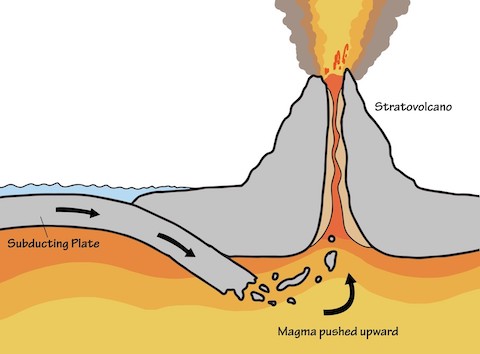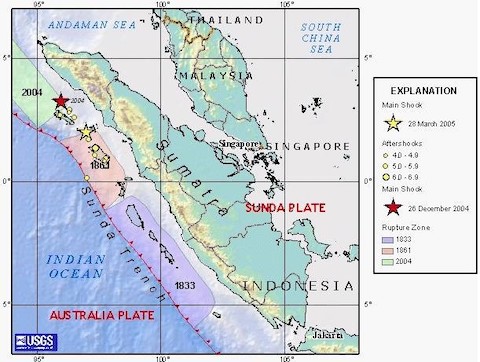
We’re all familiar with those violent shaking events we call earthquakes. But it may surprise you to know that Earth more often moves without quaking in what’s called a slow or silent slip. It sure surprised scientists: they discovered this just 20 years ago.
Earth’s tectonic plates began to move over a billion years ago. Their constant motion has formed, pulled apart, and slowly destroyed continents for millennia.
Each tectonic plate rotates around an axis, while its edges collide with, slide over, or subduct under other plates.
While some of this movement occurs in dramatic releases of stress that produce earthquakes, nearly as much energy is built up and released in slow motion—so slow it’s hard to measure.
Scientists found evidence of one slow-slip event that went on for 32 years around Sumatra, before it finally gave way catastrophically, in the tragic earthquake of 1861.
They discovered this by looking at old coral.
In times of rising sea level, corals grow upward, seeking sunlight.
In the waters around Sumatra, they found five times the coral growth rate over those three decades, revealing that the ocean floor beneath the reef was subsiding, as the Indo-Australian Plate slowly slipped beneath the Eurasian Plate.
Understanding slow-slip events like this may one day allow scientists to better predict the earthquakes that often follow them.
Background
Synopsis: Satellite technology helps scientists track the continuous movement of Earth’s tectonic plates. Each plate follows a specific path, so inevitably, plates crush into each other. As stress builds up, rocks deform and break, causing major earthquakes. But what happens in the time between powerful earthquakes? Silent or slow-slip events gently release energy over days, weeks or even years on some fault segments, while dangerously storing energy on others. The longest known slow-slip event took 32 years from start to finish in the mid-1800s, documented by growth directions of coral growth near the Indonesian island of Sumatra, and culminating in a tragic 1861 earthquake. Past events help us understand the connection between silent events and subsequent violent quakes.
- The same GPS technology that makes it possible for us to track our travel progress on a map also allows scientists to track the motion of Earth’s plates relative to each other.
- Each plate rotates around a specific rotational pole that dictates its direction.
- The Eurasian Plate moves southward at a rate of about 0.4 in (1 cm) per year, while the Indo-Australian Plate moves northward at about 3 in (7 cm) per year.
- Differences in the speed and direction of plates result in tectonic collisions along their margins at earthquake-prone subduction zones.

- The word earthquake evokes images of violent shaking of the ground as rocks move along faults in the subsurface, often with dire consequences.
- The balance between tectonic stresses and frictional forces that prevent sliding causes rocks deep in the subsurface to store energy as strain along zones of weakness known as fault planes.
- As strain exceeds frictional strength, the rock ruptures along fault planes, releasing stored energy as seismic waves that ripple through the earth, shaking the ground in multiple directions as they reach the surface.
- If an earthquake occurs near a large body of water, quick shifts of the seabed may generate a tsunami, wrecking even more havoc hundreds of miles away.
- In the past couple of decades, GPS data have shown that in certain segments of subduction zones plates tend to slide smoothly past each other, while other segments tend to rupture suddenly.
- These silent earth movements are known as slow-slip events and are common along most of Earth’s subduction zones.
- They were first documented in the Cascadia and Nankai regions of the Pacific Plate and are now known to exist near New Zealand, Costa Rica and Alaska.
- They may not be noticeable at the surface while slowly releasing energy, but slow-slip events may contribute to buildup of strain along adjacent fault segments.
- An entire range of silent events may occur over days, weeks, or months, and recent studies show that one slow-slip event lasted for 32 years!
- The Indo-Australian Plate is subducting beneath the Eurasian Plate as they converge along the Sunda subduction zone from Myanmar to Australia, building the islands of Indonesia in the process.
- Numerous earthquakes have been recorded in the region since 1797, many with associated tsunamis.
- These include catastrophic modern quakes in 2004 and 2005.
- While GPS can be used to track modern earth movements, scientists must use other indicators to understand the timelines of historical events, so researchers recently examined records of coral growth near Indonesia’s island of Simeulue, off the coast of Sumatra.
- Corals die and erode when water levels drop and by contrast grow outward with constant sea level. But if water levels rise, they tend to grow upward into the photic zone for the benefit of their symbiotic photosynthetic algae (ED-219).
- Corals near Simeulue have a constant record of vertical growth starting in 1738.
- Before 1829, the Sumatran coral grew 1–2 mm per year, but from 1829 to 1861 growth rates increased to 10 mm per year, indicating a 32-year increase in local subsidence that is attributed to slow-slip movement.

- The slow-slip event ended on February 16, 1861, when a major earthquake occurred along the Sunda megathrust subduction zone southwest of the island of Sumatra.
- The earthquake had an estimated magnitude of at least 8.5.
- It unleashed a tsunami that killed several thousand residents as it devastated communities along 500 miles of coastline with runups of up to 21 ft (7 m).
- Six large aftershocks occurred through September 1861.
- After the 1861 quake, the coral returned to its pre-1829 growth rate.
- Understanding the relationship of the 1829–1861 slow-slip event to the ensuing earthquake provides context for both recent and future high intensity earthquake events.
- The most famous of these tragic regional earthquakes occurred on December 26, 2004: the 9.2-magnitude Sumatra–Andaman earthquake (ED-002) lasted nearly 10 minutes, rupturing more than 780 mi (1,255 km) of seafloor to the southwest of Sumatra.
- The earthquake caused the Boxing Day Tsunami with a runup of around 100 ft (30 m). More than 225,000 fatalities occurred in 14 countries.
- The Indian Ocean Tsunami Warning System was set up in early 2005 immediately after the tragedy to provide an early warning of potential tsunamis for inhabitants around the Indian Ocean coasts.
- Another 8.6 magnitude quake in 2005 killed 915 and had eight major aftershocks with magnitudes over 5.5, generating a small tsunami.
- The coral reef popped up above sea level in 2005, enabling studies of the timeline for the 1829–1861 event.
- Both of these earthquakes occurred just northwest of the rupture area for the 1861 quake.
- The most famous of these tragic regional earthquakes occurred on December 26, 2004: the 9.2-magnitude Sumatra–Andaman earthquake (ED-002) lasted nearly 10 minutes, rupturing more than 780 mi (1,255 km) of seafloor to the southwest of Sumatra.

- Many of the known slow-slip regions are under continuous monitoring using land-based GPS stations and sea-based pressure monitors.
- Some have regular periods: Cascadia moves about every 14 months while Nankai shifts every three to six months.
- Another small island offshore of South Sumatra called Enganno is now subsiding faster than usual, so researchers are keeping an eye on it.

